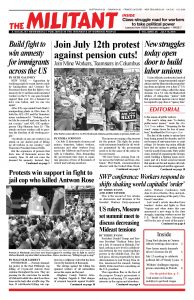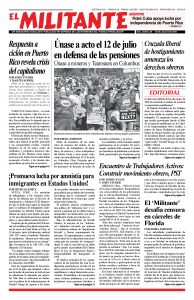Union officials, meritocratic heads of “progressive” nongovernmental organizations and the liberal media are predicting doom and gloom over a June 27 U.S. Supreme Court ruling called the Janus decision. On a 5-4 vote, the black-robed arbiters of ruling-class “justice” held that government agencies can no longer be required to pay dues or “agency fees” to the unions of public workers.
The court’s ruling aims “to destroy public-sector unions,” wrote the New York Times editors. “‘Preparing for the worst’: unions brace for loss of members,” headlined the Washington Post.
The fact of the matter is unions have been losing ground for decades, and it’s not because of anti-union laws or court rulings. It’s because top union officials have tied our unions to getting out the vote for mostly Democratic Party politicians, instead of organizing the unorganized, building a fighting union movement, part of a broad social movement that speaks out for and inspires all workers, the unemployed and the oppressed.
This is all the more true for the public worker union officials, who argue that you’re voting not just for a so-called “friend of labor,” you’re voting for who will be your boss.
For these officials, the system guarantees their dues base, even if they do nothing to organize and mobilize workers to defend the interests of their class.
Under this approach union membership in privately owned factories, mines, transportation and retail declined from 35 percent in the 1950s to 6.5 percent today. The unionization rate among public employees is at 34.4 percent, about where it was 35 years ago.
The recent teacher strikes and protests in West Virginia, Oklahoma, Kentucky, Arizona, Colorado and North Carolina this spring were a breath of fresh air, pointing the way forward for revitalizing the labor movement and winning new members to the unions.
“We’ve seen a 13 percent jump in membership because of the walkout,” said Ed Allen, president of the Oklahoma City Federation of Teachers. Similarly, in other states, school workers are seeing new ways of using union power and joining up.
A number of the states where teachers’ fights shook things up are so-called right-to-work states where mandatory dues checkoff and collective bargaining rights for teachers are denied, and state legislatures set pay levels and working conditions. But none of this stopped rank-and-file workers from mounting these fights, strengthening their unions and making real gains.
In forging a class-struggle union in Minneapolis and the upper Midwest in the 1930s, Teamsters Local 574, led by members of the Socialist Workers Party and other militants, provides an invaluable example of how to deal with this question today. In his book Teamster Power, former Teamster and SWP leader Farrell Dobbs described perfectly the “bureaucratic view” that “sees the closed shop as a liberating instrument — for the bureaucrats, that is, not the workers” — because it enabled the officials to “more or less freely ignore or go against the wishes of the rank and file. No matter how dissatisfied this may make the workers, dues must still be paid, and the bureaucrats continue to have a union treasury at their disposal.”
Teamsters union militants collected dues by visiting workers and discussing what had to be done to strengthen the union.
“When workers are inspired by the union,” Dobbs said, “they develop a healthy resentment against freeloaders on the job and look for ways of forcing them at least to contribute financially to the cause. That leads them to favor putting a clause in the agreement with the employer making payment of union dues compulsory.”
Far from the unions being doomed, the teachers’ struggles pointed the way forward to advance the fighting capacity of our unions today.

